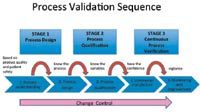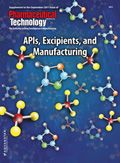News
Article
Pharmaceutical Technology
FDA's New Process Validation Guidance: Industry Reaction, Questions, and Challenges
The authors desribe the three-stage approach to validation that is outlined in the new guidance and discuss questions surrounding implementation.
FDA's 2011 Process Validation: General Principles and Practices guidance created a systemic shift in industry's approaches to validation programs. The authors describe the three-stage approach to validation that is outlined in the new guidance and discuss questions surrounding implementation.
In January 2011, FDA published its long-awaited guidance for industry on Process Validation: General Principles and Practices (1). For many in the pharmaceutical industry, the guidance created a systemic shift in the expectations of their validation programs. Although the new guidance aligns process-validation activities with the product life-cycle concept and with existing harmonized guidelines such as the Internatioanl Confernce on Harmonization's Q8(R2) Pharmaceutical Development, Q9 Quality Risk Management, and Q10 Pharmaceutical Quality System, it may have created as many questions for the industry as it has answered. In this article, the authors briefly describe the three-stage approach to validation that is outlined in the new guidance as well as implications for manufacturers regarding their current approaches to process validation. Specific emphasis is placed on questions surrounding industry implementation.
Design for assurance
The regulatory basis for process validation is contained in a number of places. Process validation is legally enforceable per the Federal Food, Drug, and Cosmetics Act. The requirements are called out in 21 CFR Parts 210 and 211 of the CGMP regulations, more specifically in Part 211.100 (a). This section is what the FDA describes as the regulatory "foundation for process validation" (1). Here, manufacturers are required to have production and process-controls procedures in place that are "designed to assure" drug products have a certain level of quality and that their products are manufactured safely, effectively, and purely.
How is that assurance to be provided, however? How can industry design to assure these qualities? One way is through direct observation; another is through prediction. Direct observation may require the destruction of the products, meaning that industry generally must use predictive methods to determine, with a certain level of confidence, that its processes and controls are designed to assure quality. Validation is the predictive method for providing this assurance.
A brief history of validation
In the 1970s, there was a series of contamination issues in large-volume parenteral bottles that, with a handful of other significant adverse events, led regulatory authorities and manufacturers to focus more on process understanding and quality assurance. The idea that finished product testing was not enough to assure product quality began to grow. Industry needed a better system to determine whether a product was "good" (2).
In the mid-1970s, FDA's Ted Byers and Bud Loftus began to promote the idea that a focus on process design and an evaluation of support processes and functions would assist in assuring that processes were under control (rather than just " testing quality into the product"). At a 1974 conference, Byers called this new predictive approach "Design for Quality" (3).
In 1987, at the request of industry, FDA published its original guideline on General Principles of Validation (4). The agency established a more formal approach to process validation and created the assertion that multiple batches need to be run. This concept eventually translated into the three-batch approach, where the successful running of three consecutive product batches represents a validated process. Herein are fundamental questions that still exist 20 years after the publication of the guidance:
- If companies were following the guidance, why would companies continue to see processes fail during commercial manufacture?
- Were companies really providing high degrees of assurance their processes worked reliably?
- Did companies understand how or why running three batches proved that their processes were adequately controlled and capable of consistently providing required results?
When these questions are asked of people in the industry, the answers, in the authors' experience, are invariably, "Well, stuff happens. Things happen. Things we didn't anticipate." "Stuff happens" tends to refer to "process variation," a key term and a key reason why the 1987 guidance was updated.
The new guidance
The new guidance ushers in a life-cycle approach to validation. This approach is most apparent in the guidance's new definition for process validation: "...the collection and evaluation of data, from the process design through commercial production, which establishes scientific evidence that a process is capable of consistently delivering quality products" (1)
The words used have been selected carefully. The new definition talks about establishing process capability using scientific evidence while previous definitions used the phrase "documented evidence" (4). This earlier definition may have contributed to validation being viewed largely as a late-stage documentation exercise. The new definition, however, describes process validation as a continuous process of collection and evaluation of data, rather than as a three-batch static event. As one FDA representative commented at a recent PDA workshop, the number of batches is not an acceptance criteria; however, the results of the data obtained from the batches are (5). The new definition of validation caused one industry member to lament at the workshop that for the past 30 years, industry has been told that process validation is a documentation exercise. Now, FDA expects industry to consider process validation as a scientific endeavor. That is quite a shift and 30-year habits are hard to break, he noted (5).
This statement underlies the dichotomy that exists within the industry regarding the new guidance. For years, the industry criticized regulators that the industry owned the expertise, knew their processes better than regulatory agencies, and should have flexibility in how they could validate these processes. The agency listened and came back with a guidance that is deliberately non-prescriptive; it doesn't tell industry how many samples to pull or how many batches to run. The industry has to be able to answer these questions and they are not always easy to answer.
Defining the new process-validation stages
As noted, the 2011 guidance enforces the life-cycle model described in ICH Q10 and in FDA's 2006 guidance for industry on Quality Systems Approach to Pharmaceutical CGMP Regulations, which states that, "quality should be built into the product, and testing alone cannot be relied on to ensure product quality" (6, 7). The method of building quality into a product or "designing for assurance" challenges manufacturers to better:
- Understand the sources of variation along the supply chain in the manufacturing process
- Detect the existence and amount of variation that is imparted into the product from sources within the supply chain, the equipment, and personnel
- Understand the impact of the detected variation on the finished product
- Control the variation detected based upon the understanding and knowledge of the sources of the variation that proportional to its risk to product and patient (1).
The new guidance document describes validation activities in three stages using a life-cycle model (see Figure 1). Although explained as discrete stages, some activities can occur in multiple stages while others may overlap between stages. Risk assessments are a good example of such activities. The guidance describes these three stages as follows (see Figure 1):
- Stage 1–Process Design: The commercial-manufacturing process is defined during this stage based on knowledge gained through development and scaleup activities.
- Stage 2–Process Qualification: During this stage, the process design is evaluated to determine whether the process is capable of reproducible commercial manufacturing.
- Stage 3–Continued Process Verification: Ongoing assurance is gained during routine production that the process remains in a state of control (1).
These stages are defined in more detail in the following sections.

Figure 1: The three stages of the validation life-cycle model based on the new FDA process validation guidance. (Authors)
Stage 1–Process Design. Process validation is an ongoing process within the product life cycle. This cycle begins at Stage 1. Here, the commercial process starts to be defined using knowledge gained through development and scale-up activities (1). Process knowledge and understanding is captured in Stage 1 to determine initial process capability and to evaluate sources of variation. Design of experiments can be used to identify and establish process-parameter relationships with quality attributes. Risk-management efforts should begin in earnest at this phase to assist in capturing the product and process knowledge and to prioritize development efforts, which can be ranked by the relative importance of the quality attributes. Process-control strategies can begin to be developed during this stage through initial understanding of the risks and sources of variation (8).
Stage 2–Process Qualification. Although the 2011 guidance document's three-stage description of validation may be new to the industry, the content and concepts within Stage 2 should be the most familiar. During this stage, the process design is confirmed as being capable of reproducible commercial manufacturing. This phase involves evaluating the facility and equipment for its fitness for use. Utility systems and equipment are verified to be built and installed properly, and operators ensure that they operate within the intended and anticipated operating ranges. The conclusion of this stage commences with the execution of a process-performance qualification (PPQ) exercise. PPQ is a significant milestone in the product life cycle. The decision to distribute product to the market will be determined by the successful completion of PPQ. The amount and usefulness of the product and process knowledge gained up to this point in the life cycle will determine the approach a company takes with its PPQ (1). The focus at this stage should not be on the number of batches needed to produce a successful PPQ run, but rather, on whether enough data has been produced and evaluated to answer two basic questions:
- What scientific evidence is there to provide the appropriate level of assurance that the manufacturing system has been designed to consistently deliver a quality product to the market?
- Are there systems in place to properly monitor and control that manufacturing system?
Stage 3–Continued Process Verification. Stage 3 of the 2011 guidance is the continuous-improvement phase of the process-validation life cycle. In this phase, data obtained from routine production is used to provide ongoing assurance that the process remains in the state of control. This activity is more than an annual product review; rather, this action involves using a system or multiple systems of assuring control.
Control strategies originally conceived in Stage 1 are implemented during this phase as well. Tracking and trending of data allows for the detection of special-cause variability and the reduction of inherent common-cause variability. Determination on the state of control of the processes in commercial distribution should be calculated using appropriate statistics and derived from appropriate confidence levels. These confidence levels should be based upon risk factors, experience, and attribute criticality (1).
A continuous process of evaluation
With the new life-cycle approach, process validation is no longer a one-time milestone event. Process validation should be considered a continuous process of valuation. The five steps shown in Figure 2 represent stages of validation. These steps require industry to:
- Know the process
- Know the variables
- Have confidence before going into commercial manufacture
- Create vigilance in understanding variation through monitoring and continuous improvement that the process is under control.
Initial process understanding for a given product is most often based upon a combination of early development work on the product along with prior knowledge of the existing product and manufacturing platforms that will be used to commercialize the product. It is quite rare that a product entering the validation lif cycle will have a unique product or manufacturing platform. This initial process knowledge allows for a more robust process-design phase, which creates an enhanced understanding of the sources of variation and their impact on the product's quality attributes. Understanding the sources of variation provides confidence to go into commercial manufacture and to create an ongoing monitoring program that will track and trend data for continuous improvement.

Figure 2: The process-validation sequence.(Figures are courtesy of authors)
Industry reaction and challenges
The industry reaction to the 2011 process validation guidance, in general, has been favorable. The document is nonprescriptive. It is relatively flexible. It leaves much to the companies to decide how they wish to meet its expectations. But, as the authors discovered through a series of industry workshops and seminars, there still is a need for further explanation and clarification regarding the guidance as well as a real need for detailed implementation suggestions. Although there are many questions to be answered, this paper is limited to three of the most frequently asked questions about implementing the new guidance.
Common questions. The classic and most frequently asked question about the new guidance is, How many batches do I have to run to validate my processes under the new guidance? The answer does not delight many people: "It depends."
The number of batches needed to validate a process depends on how much data are required to provide a company with an appropriate level of statistical confidence and scientific justification to begin commercial production. There is nothing wrong with a company choosing to run three batches for validation, but that company has to be prepared to explain why the data obtained from three batches is sufficient to determine that the process is ready to move into commercial manufacturing. Likewise, if a company chooses to run fewer than three batches, it has to be able justify the amount of data created by those batches. In short, there is no longer a uniform number of validation batches that can be applied globally to the industry. The approach is now process- and product-specific, depending on a company's ability to test critical parameters, conditions, and attributes.
Overall, the batches are a means to an end, and in this case, that end is data (9).
The discussion of the number of batches required invariably leads to a second frequently asked question, How do we determine the amount of data we need in our validations? The question revolves around the amount of data needed in Stage 2–Process Qualification. FDA has been quite clear that statistical justification for sampling is required. Specifically, the guidance states that:
- The number of samples should be adequate to provide sufficient statistical confidence of quality both within a batch and between batches.
- The confidence level selected can be based on risk analysis as it relates to the particular attribute under examination.
- Sampling during this stage should be more extensive than is typical during routine production (1).
A key to success here will be appropriate use of risk analysis to assist in selection of appropriate confidence levels for a product's critical quality attributes (CQAs). All CQAs are not alike, the higher the risk for a given CQA, the higher the confidence level required during validation. The amount of data required might then increase for those CQAs that require higher confidence levels. This decision will depend on the test methods used and the type of data collected. Test methods that create dichotomous data (pass/fail, go/no go) will require many more samples than those that produce continuous (i.e., variable) data. This difference needs to be taken into consideration early in the validation life-cycle process becaues it also impacts how data will be trended in Stage 3.
Another question brought up frequently is, Do the requirements in the guidance conflict with existing global regulatory requirements? This question has two components to it.
First, there is a specific concern that validation terms within the document do not align with EMA terms, specifically Annex 15 of the European Union Guidelines to Good Manufacturing Practice, or those in ICH Q7 (10, 11). Examples of misalignment would be traditional terms such as installation qualification and operational qualification. These terms are not included in the new FDA process validation guidance, but the concept described in Stage 2 of the guidance does state that, "qualification refers to activities undertaken to demonstrate that utilities and equipment are suitable for their intended use and perform properly." This language is similar in nature to Sections 9–13 of the EU GMP Annex and Section 12.3 of ICH Q7 (1, 10, 11).
Second, there is a concern that certain concepts within the EU GMPs conflict with the new FDA guidance, specifically regarding the three-batch validation approach. Section 25 of the EU GMP Annex 15 states, "It is generally considered acceptable that three consecutive batches/runs within the finally agreed parameters, would constitute a validation of the process" (10). On the surface, this language would seem to conflict with the FDA's new focus on data rather than the number of batches. However, Section 25 of the EU GMP Annex 15 also states that, "...the number of process runs carried out and observations made should be sufficient to allow the normal extent of variation and trends to be established and to provide sufficient data for evaluation." So, while the three-batch approach to validation is embedded in Annex 15, Section 25 also provides for a more flexible approach based upon data (10).
Related to the question above are general questions regarding terminology. The most notable new term in the FDA guidance is process performance qualification (PPQ), described earlier in this paper. The guidance defines PPQ as "the second element of Stage 2, process qualification. The PPQ combines the actual facility, utilities, equipment (each now qualified), and the trained personnel with the commercial manufacturing process, control procedures, and components to produce commercial batches. A successful PPQ will confirm the process design and demonstrate that the commercial manufacturing process performs as expected" (1). PPQ is what most companies call their process validation (PV) and should not be confused with individual equipment process qualifications. Here again, FDA has stated that the concepts are important, not the terms (9). Companies are free to call these activities what they wish as long as the two parts of Stage 2 as outlined in the guidance are met.
Challenges. Changing the existing validation culture to meet the expectations of the new guidance may be the biggest challenge industry faces. The guidance requires companies to expand their current scope of validation by reaching further upstream into development and downstream into day-to-day manufacturing. Companies agree this expansion will foster better communication from the development groups through to manufacturing but are concerned that it also requires additional staffing. To better understand and meet this challenge, companies should create gap analyses of their current state of validation and compare it with the future state based on the new guideline. These gap analyses will better situate companies to create action plans for the new policies and procedures that may need to be put into place. The analyses will also assist in identifying any resource gaps and training needs.
Conclusion
FDA's new process validation guidance has received generally favorable reviews for its nonprescriptive and flexible approach. With this flexibility, however, comes a concern about acceptable approaches for implementation at a practical level and a genuine need for a continued dialogue of explanation and clarification between the agency and industry. Due to limitations, this article could only touch on a handful of the questions being asked at this time. The authors endeavor to create a series of articles in Pharmaceutical Technology to further address issues such as the use of risk management along the three stages of validation, collection and transfer of product and process knowledge along the validation life cycle, and continued process verification.
Dr. Mike Long, MBB,* is director of consulting services, and Walter D. Henkels, Sr., is a consultant, both at ConcordiaValsource. Hal Baseman is chief operating officer of ValSource LLC. Mlong@concordiaValsource.com
*To whom all correspondence should be addressed.
References
1. FDA, Guidance for Industry: Process Validation: General Principles and Practices (Rockville, MD, Jan. 2011).
2. US vs. Barr Laboratories, 1993.
3. J. M. Dietrick and B.T. Loftus, "Regulatory Basis for Process Validation" in Pharmaceutical Process Validation, R.A. Nash and A. H. Wachter, Eds. (Marcel Dekker New York, NY, 3rd ed., 2003) p. 43.
4. FDA, Guideline on General Principles of Process Validation (Rockville, MD, May 1987, reprinted May 1990).
5. PDA Annual Meeting Post-Conference Workshop, "The FDA's Process Validation Guidance: Meeting Compliance Expectations and Practical Implementation Strategies" (San Antonio, TX, April 13–14, 2011).
6. ICH, Q10 Pharmaceutical Quality System (2008).
7. FDA, Guidance for Industry: Quality Systems Approach to Pharmaceutical CGMP Regulations (Rockville, MD, September 2006).
8. M. Long and H. Baseman, presentation at the Elsevier Business Intelligence Webinar, May 18, 2011.
9. G. McNally, presentation at the PDA Annual Meeting Post-Conference Workshop (San Antonio, TX, April 13–14, 2011).
10. EU, Guidelines to Good Manufacturing Practice, Medicinal Products for Human and Veterinary Use, Annex 15: Qualification and Validation (Brussels, July 2001).
11. ICH, Q7 Good Manufacturing Practice Guide For Active Pharmaceutical Ingredients (November 2000).

Newsletter
Get the essential updates shaping the future of pharma manufacturing and compliance—subscribe today to Pharmaceutical Technology and never miss a breakthrough.





